Chapter: Cryptography and Network Security Principles and Practice : One Symmetric Ciphers : Basic Concepts in Number Theory and Finite Fields
Polynomial Arithmetic
POLYNOMIAL
ARITHMETIC
Before continuing our discussion of finite fields,
we need to introduce the interest-
ing subject of polynomial arithmetic. We are concerned with polynomials in a single variable x, and we can distinguish three
classes of polynomial arithmetic.
•
Ordinary polynomial arithmetic, using the basic rules
of algebra.
•
Polynomial
arithmetic in which the arithmetic on the coefficients is performed modulo p ; that is, the coefficients are in GF(p).
•
Polynomial arithmetic
in which
the coefficients are in
GF(p), and the polynomials are defined
modulo a polynomial m(x)
whose highest power is some integer
n.
This section examines the first two classes,
and the next section covers the last
class.
Ordinary Polynomial Arithmetic
A polynomial of
degree n (integer n >= 0) is an expression of the form

where the ai are elements of some
designated set of numbers S, called
the coefficient set, and an != 0. We say that such polynomials are defined over the coefficient set S.
A zero-degree
polynomial is called a constant
polynomial and is simply an element of the set of coefficients. An nth-degree polynomial is said to be a monic polynomial if an = 1.
In the context
of abstract algebra,
we are usually not interested in evaluating a
polynomial
for a particular value of x [e.g.,
f(7)]. To emphasize this point, the variable
x is sometimes referred to as the indeterminate.
Polynomial arithmetic includes the
operations of addition, subtraction, and multiplication. These operations are defined in a natural
way as though the variable
x was
an element of S. Division is
similarly defined, but requires that S be a field. Examples of fields include
the real numbers,
rational numbers, and Zp for p prime. Note that the set of all integers
is not a field and does not support polynomial division.
Addition and subtraction are performed
by adding or subtracting corresponding
coefficients. Thus, if
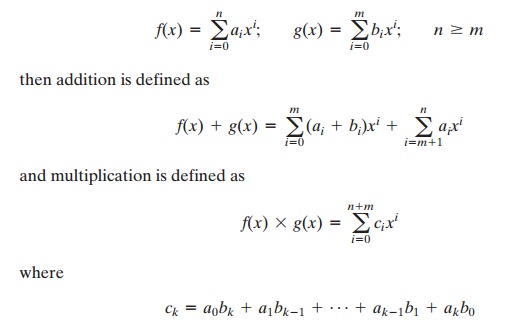
In the last formula, we treat ai as zero for i > n and bi as zero for i > m. Note that the degree of the product
is equal to the sum of the degrees of the two polynomials.
As an example, let f(x) = x3 + x2 + 2 and g(x) = x2 - x + 1, where S is the
set of integers. Then
f(x) + g(x) = x3 + 2x2 - x + 3
f(x) - g(x) = x3 + x + 1
f(x) * g(x) = x5 + 3x2 - 2x + 2
Figures 4.3a through 4.3c show the manual calculations. We comment
on division subsequently.
Polynomial Arithmetic with Coefficients in Zp
Let us now consider polynomials in which the
coefficients are elements of some field
F; we refer to this as a polynomial over the field F. In that case, it is easy to show that the set of such
polynomials is a ring, referred to as a polynomial
ring. That is, if we consider each distinct polynomial to be an element of
the set, then that set is a ring.
When polynomial arithmetic is performed on polynomials over a field, then division is possible. Note that this does not mean that exact division is possible. Let us clarify this distinction. Within a field, given two elements a and b, the quotient a/bis also an element of the field. However, given a ring R that is not a field, in
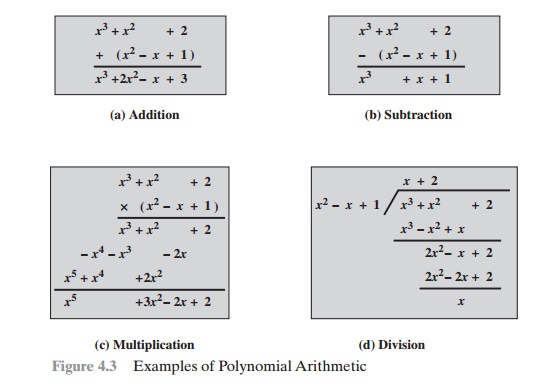
general, division will result in both a quotient and a remainder;
this is not exact division.
Consider
the division 5/3 within a set S. If S is the set of rational numbers, which is a field, then the
result is simply expressed as 5/3 and is an element of S. Now suppose that S is
the field Z7. In this case, we calculate (using
Table 4.5c)
5/3
= (5 * 3 - 1) mod 7 = (5 * 5) mod 7 = 4
which is an exact solution. Finally,
suppose that S is the set of integers, which is a ring but not a field. Then
5/3 produces a quotient of 1 and a remainder of
2:
5/3 =
1 + 2/3
5 = 1 * 3 + 2
Thus, division is
not exact over the set of integers
Now, if we attempt to perform polynomial division over a
coefficient set that is not a field, we find that division is not always defined.
If the coefficient
set is the integers, then (5x2)/(3x) does not
have a solution, because it would require a coefficient with a value of 5/3,
which is not in the coef- ficient set. Suppose that we perform the same
polynomial division over Z7. Then we have (5x2)/(3x) = 4x, which is a valid polynomial over Z7.
However, as we demonstrate presently, even if
the coefficient set is a field, poly- nomial division is not necessarily exact. In general, division will produce a quotient and a remainder. We can restate the division algorithm of Equation
(4.1) for polynomials over a
field as follows. Given polynomials f(x)
of degree n and g(x) of degree (m),
(n Ú m), if we divide f(x)
by g(x), we get a quotient q(x)
and a remainder r(x) that obey the relationship

With the understanding that remainders are allowed,
we can say that polynomial division is possible
if the coefficient set is a field.
In an analogy
to integer arithmetic, we can write
f(x) mod g(x) for the remain-
der r(x) in Equation (4.10). That is, r(x)
= f(x) mod g(x). If there is no remainder [i.e., r(x) = 0], then we can say g(x) divides f(x), written as g(x) ƒ f(x). Equivalently, we can say that
g(x) is a factor of f(x) or g(x) is a divisor
of f(x).
For the preceding
example [f(x) = x3 + x2 + 2 and g(x) = x2 - x + 1], f(x)/g(x) produces a quotient of q(x)
= x + 2 and a remainder r(x)
= x, as shown in Figure 4.3d. This is
easily verified by noting that
q(x)g(x)
+ r(x) = (x + 2)(x2 - x + 1) + x = (x3 + x2 - x + 2) + x
= x3 + x2 + 2 =
f(x)
For our purposes,
polynomials over GF(2) are
of most interest.
Recall from Section 4.5 that in GF(2), addition is equivalent to the XOR
operation, and multi- plication is equivalent to the logical AND operation.
Further, addition and subtraction are equivalent mod 2: 1 + 1 = 1 - 1 = 0; 1 +
0 = 1 - 0 = 1; 0 + 1 = 0 - 1 = 1.
Figure 4.4 shows
an example of polynomial
arithmetic over GF(2). For f(x)
= (x7 + x5 + x4 + x3 + x + 1) and g(x)
= (x3 + x + 1), the
figure shows f(x) + g(x); f(x) - g(x); f(x) * g(x); and f(x)/g(x). Note that g(x)| f(x).
A polynomial f(x)
over a field F is
called irreducible if and only if f(x)
cannot be expressed as a product of two polynomials, both over F, and both of degree lower than that of f(x).
By analogy to integers, an irreducible polynomial is also called a prime polynomial.
The polynomial9
f(x) = x4 + 1
over GF(2) is reducible, because
x4 + 1 = (x + 1)(x3 + x2 + x + 1).
Consider the polynomial f(x) = x3 + x + 1.
It is clear by inspection that x is
not a factor of f(x).
We easily show that x + 1 is not a factor of f(x):
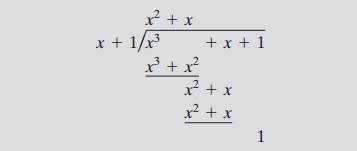
Thus, f(x)
has no factors of degree 1. But it is clear by inspection that if f(x)
is reducible, it must have one factor of degree 2 and one factor of degree 1.
Therefore, f(x) is irreducible.
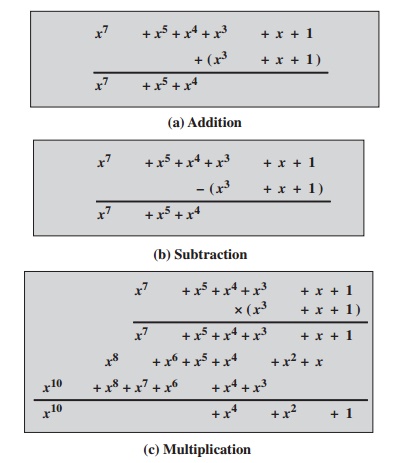
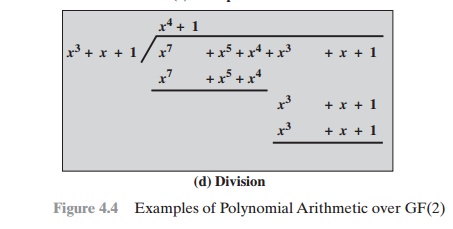
Finding the Greatest Common Divisor
We can extend the analogy
between polynomial arithmetic over a field and integer arithmetic by defining the greatest common
divisor as follows.
The polynomial c(x)
is said to be the greatest common
divisor of a(x) and b(x) if the following are true.
1.
c(x) divides both a(x) and b(x).
2.
Any divisor of a(x)
and b(x) is a divisor of c(x).
An equivalent definition is the following: gcd[a(x), b(x)] is the polynomial of maximum degree that divides both a(x) and b(x).
We can adapt the Euclidean algorithm to compute
the greatest common divi- sor of two
polynomials. The equality in
Equation (4.6) can be rewritten as the fol- lowing theorem.
gcd[a(x), b(x)]
= gcd[b(x), a(x) mod
b(x)] (4.11)
Equation (4.11) can be used repetitively to determine the
greatest common divisor. Compare the following scheme
to the definition of the Euclidean algorithm for integers.
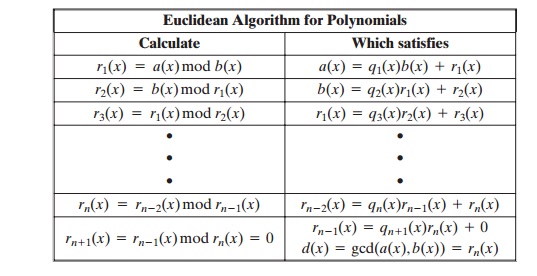
At each iteration, we
have d(x) = gcd(ri + 1(x), ri(x)) until
finally d(x) = gcd(rn(x), 0) = rn(x).
Thus, we can find the greatest common
divisor of two integers by repetitive application of the division algorithm.
This is the Euclidean algorithm for
polynomials. The algorithm assumes
that the degree of a(x) is greater than the degree of b(x).
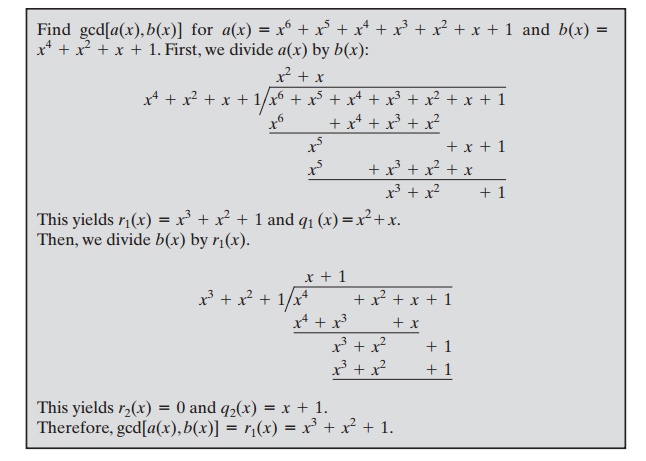
Summary
We began this section with a discussion of arithmetic with ordinary polynomials. In ordinary polynomial arithmetic, the variable is not evaluated; that is, we do not plug a
value in for the variable
of the polynomials. Instead, arithmetic operations are per- formed on polynomials (addition,
subtraction, multiplication, division) using the
ordinary rules of algebra. Polynomial division is not allowed unless the coefficients are elements of a field.
Next, we discussed polynomial arithmetic in which the coefficients are elements
of GF(p). In this case,
polynomial addition, subtraction, multiplication, and division are allowed. However, division is
not exact; that is, in general
division results in a quotient and a remainder.
Finally, we showed that the Euclidean algorithm can be extended to find the greatest common divisor of two polynomials whose coefficients are elements
of a field. All of the material in this section
provides a foundation for the following section,
in which polynomials are
used to define finite fields of order pn.
Related Topics